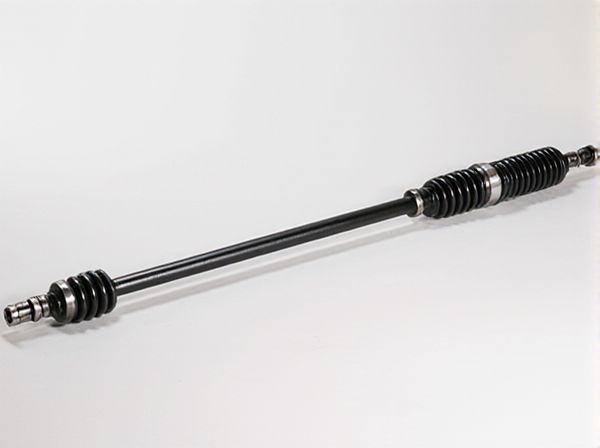
Photo illustration: Single-Piece Driveshaft vs Two-Piece Driveshaft
A single-piece driveshaft offers a simpler design with fewer components, resulting in reduced weight and increased strength, making it ideal for high-performance and off-road vehicles. A two-piece driveshaft provides greater flexibility and length accommodation, improving vibration control and allowing for easier installation in longer vehicles. Understanding your vehicle's specific needs helps determine the optimal choice for durability and performance.
Table of Comparison
| Feature | Single-Piece Driveshaft | Two-Piece Driveshaft |
|---|---|---|
| Structure | One continuous shaft | Two segments connected by a center support bearing |
| Weight | Lighter, enhances performance | Heavier due to additional components |
| Length Suitability | Best for short to medium-length driveshafts | Ideal for long driveshafts in trucks and SUVs |
| Vibration Control | Less effective at reducing vibration | Better vibration dampening via center bearing |
| Maintenance | Simple; fewer parts to inspect | Requires upkeep of center bearing and multiple joints |
| Cost | Generally less expensive | Higher cost due to complexity |
| Durability | Less durable in high-torque, long-distance applications | More durable for heavy-duty, extended use |
Introduction to Driveshaft Types
Single-piece driveshafts consist of a single, solid shaft that transmits power from the transmission to the differential, commonly used in shorter wheelbase vehicles due to their simplicity and durability. Two-piece driveshafts incorporate a center support bearing, allowing for longer lengths and greater flexibility in vehicles with extended wheelbases or off-road applications. Understanding these driveshaft types is essential for selecting the appropriate system based on vehicle design, torque requirements, and operational conditions.
What is a Single-Piece Driveshaft?
A single-piece driveshaft is a solid, one-piece tube that transfers torque from the transmission to the differential in a vehicle, providing a direct and efficient power delivery. It is typically made of steel or aluminum, offering high strength and minimal weight, which enhances performance and reduces vibrations. This type of driveshaft is commonly used in shorter drivetrain applications due to its simplicity and durability.
What is a Two-Piece Driveshaft?
A two-piece driveshaft consists of two separate shafts connected by a center bearing, allowing for greater length and flexibility in vehicle design, especially in longer wheelbase trucks and SUVs. This configuration reduces vibrations and stress by accommodating slight misalignments and improving drivetrain balance. Compared to a single-piece driveshaft, the two-piece setup offers enhanced durability and smoother operation in demanding driving conditions.
Key Differences Between Single and Two-Piece Driveshafts
Single-piece driveshafts consist of a single solid shaft, providing greater rigidity and reduced vibrations, ideal for lighter vehicles with shorter distances between axles. Two-piece driveshafts incorporate a center support bearing, allowing for longer shaft lengths and improved flexibility, making them suitable for heavier vehicles or trucks with extended wheelbases. The two-piece design also facilitates easier maintenance and better handling of torque fluctuations compared to the single-piece driveshaft.
Advantages of Single-Piece Driveshafts
Single-piece driveshafts offer superior strength and torsional rigidity due to their continuous construction, reducing the likelihood of vibration and imbalance during high-speed rotation. They provide enhanced reliability with fewer components that can fail, leading to lower maintenance and repair costs over time. Their simpler design also contributes to lighter overall weight, improving vehicle efficiency and performance.
Advantages of Two-Piece Driveshafts
Two-piece driveshafts provide enhanced durability and flexibility by accommodating misalignments and reducing vibrations during operation, making them ideal for vehicles with longer wheelbases. Their design allows for easier maintenance and repair, as individual sections can be replaced without removing the entire assembly. This configuration also improves driveline stability and extends the lifespan of drivetrain components, contributing to overall vehicle reliability.
Common Applications for Each Driveshaft Design
Single-piece driveshafts are commonly used in lighter vehicles and sports cars where simplicity, reduced weight, and high rotational speed are critical. Two-piece driveshafts are preferred in trucks, SUVs, and heavy-duty vehicles due to their ability to accommodate longer distances between the transmission and axle, reducing vibrations and enabling easier maintenance. Off-road and commercial vehicles frequently employ two-piece driveshafts for enhanced durability and flexibility in rugged conditions.
Performance and Efficiency Comparison
Single-piece driveshafts offer superior rotational balance and reduced drivetrain vibration, enhancing overall vehicle performance and efficiency at higher speeds. Two-piece driveshafts provide greater flexibility for longer wheelbases and improved ease of installation, though they may introduce slightly increased rotational mass and potential vibration points. Optimizing performance requires balancing the smoother operation of single-piece designs against the modular advantages and durability of two-piece driveshafts in specific automotive applications.
Maintenance and Durability Considerations
Single-piece driveshafts typically require less maintenance due to fewer components and joints susceptible to wear, enhancing overall durability. Two-piece driveshafts, while more complex, allow for easier replacement of individual sections and better vibration management, potentially extending the lifespan under heavy-duty conditions. Regular inspection of universal joints and slip yokes is crucial in both designs to prevent premature failure and ensure optimal drivetrain performance.
Choosing the Right Driveshaft for Your Vehicle
Selecting the right driveshaft depends on your vehicle's drivetrain layout and performance needs. Single-piece driveshafts offer simplicity, reduced weight, and are ideal for shorter wheelbases or light-duty applications, while two-piece driveshafts provide enhanced durability and vibration control, making them suitable for longer wheelbases or heavy-duty trucks. Consider factors like vehicle length, torque requirements, and ease of maintenance to determine whether a single-piece or two-piece driveshaft best supports your vehicle's functionality and driving conditions.
 caratoz.com
caratoz.com